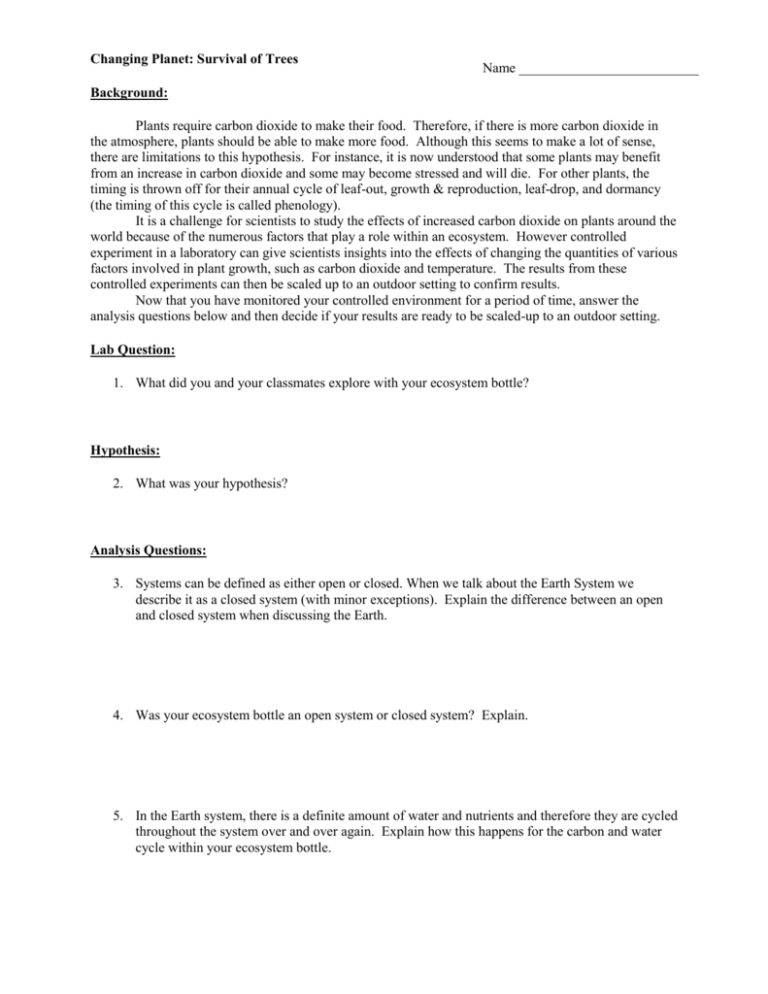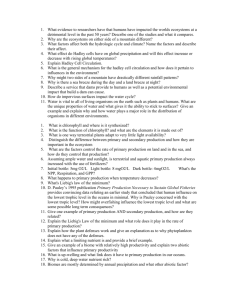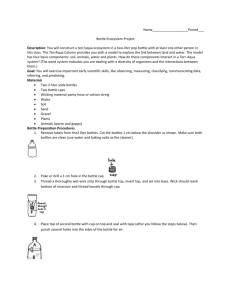
Changing Planet: Survival of Trees
Name __________________________
Background:
Plants require carbon dioxide to make their food. Therefore, if there is more carbon dioxide in
the atmosphere, plants should be able to make more food. Although this seems to make a lot of sense,
there are limitations to this hypothesis. For instance, it is now understood that some plants may benefit
from an increase in carbon dioxide and some may become stressed and will die. For other plants, the
timing is thrown off for their annual cycle of leaf-out, growth & reproduction, leaf-drop, and dormancy
(the timing of this cycle is called phenology).
It is a challenge for scientists to study the effects of increased carbon dioxide on plants around the
world because of the numerous factors that play a role within an ecosystem. However controlled
experiment in a laboratory can give scientists insights into the effects of changing the quantities of various
factors involved in plant growth, such as carbon dioxide and temperature. The results from these
controlled experiments can then be scaled up to an outdoor setting to confirm results.
Now that you have monitored your controlled environment for a period of time, answer the
analysis questions below and then decide if your results are ready to be scaled-up to an outdoor setting.
Lab Question:
1. What did you and your classmates explore with your ecosystem bottle?
Hypothesis:
2. What was your hypothesis?
Analysis Questions:
3. Systems can be defined as either open or closed. When we talk about the Earth System we
describe it as a closed system (with minor exceptions). Explain the difference between an open
and closed system when discussing the Earth.
4. Was your ecosystem bottle an open system or closed system? Explain.
5. In the Earth system, there is a definite amount of water and nutrients and therefore they are cycled
throughout the system over and over again. Explain how this happens for the carbon and water
cycle within your ecosystem bottle.
6. An important aspect of the Earth system is that there is a balance of energy entering and leaving
the system. However changes in an aspect of the system may upset this balance and global
temperatures could rise or fall. A period of time is needed for the system to become balanced
again, although the Earth may exist be at a higher or lower temperature. Describe how this
occurs in the Earth system.
7. Are incoming and outgoing energy balanced in the ecosystem bottle? What can upset the balance
in the bottle?
8. What would happen if the bottle were placed in a sunny window?
9. What would happen if the bottle was placed under a plant-growth light that was "on" all the time?
10. What is the role of the plants in the ecosystem bottle?
11. Identify the abiotic factors within your ecosystem.
12. Recall the formula for photosynthesis and the fact that carbon dioxide is necessary for that
reaction to take place. Also recall that we sealed the bottle and that plants survived in the sealed
bottle. Where did the necessary carbon dioxide come from in order for the plants to thrive in the
bottle?
13. Define the term limiting factor.
14. Over time what would happen to the amount of plant material in the bottle? Explain why.
15. What would happen to the leaves that die?
16. The ecosystem bottle and the Earth system have many similarities as we have identified, but the
differences are just as important. What are some of those differences, and why are they
important?
17. The plants in our ecosystem bottle can remain for a very long time - in fact - for years! What
would happen if an insect or a toxic substance was introduced to our system?
18. What would happen to your biosphere bottle if you could increase the concentration of carbon
dioxide gas in the air inside the bottle?
19. Use the space below to describe the procedure you would use to test one of the questions posed in
#8 or #9.
The source of this material is Windows to the Universe, at http://windows2universe.org/ from the National Earth Science Teachers Association
(NESTA). The Website was developed in part with the support of UCAR and NCAR, where it resided from 2000 - 2010. © 2010 National Earth
Science Teachers Association. Windows to the Universe® is a registered trademark of NESTA. All Rights Reserved.








